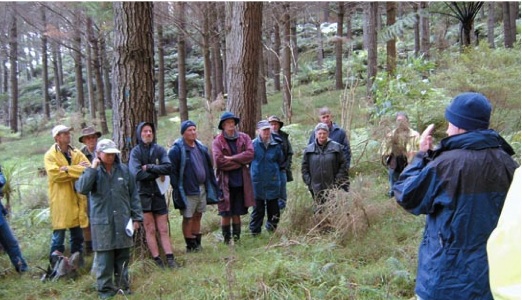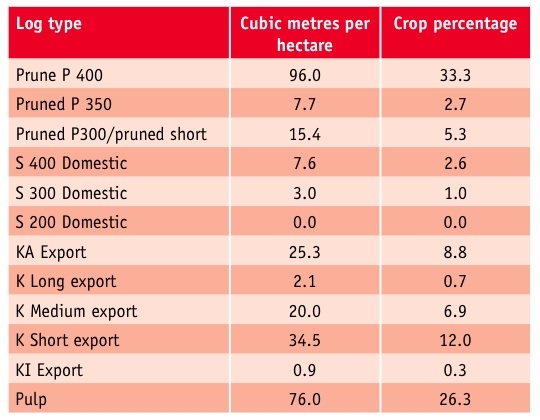MARVL pre-harvest inventory system
Jim Cooke & Rob Webster, New Zealand Tree Grower May 2005.
No, MARVL is not shorthand for one of the wonders of the world but something much more prosaic.
MARVL is an acronym for ‘method of assessment of recoverable volume by log type.’ It is a pre-harvest inventory system which allows codes and defects to be assigned to lengths of the bole of sampled trees. A multitude of user-defined cutting strategies may then be developed to optimise the value of logs produced in accordance with the assignment of quality codes to log types and their relative current market prices.
Dry theory
Assessment of forestry populations is a specialised area of statistics and sampling theory. Measurement must be undertaken in a manner that provides an accurate estimate of the true mean of the tree population together with a realistic assessment of the precision of the estimate. Inaccuracy generally results from bias or faulty measurement techniques, whereas imprecision results from sampling error or from the inability to account for natural or random variability.
Have we lost you yet, for the above is the dry theory of what is a very important part of a forest grower’s rotation coming as it does before the trees are harvested, and the grower finds out what is likely to be their return.
MARVL field day
Over 30 members of the Lower North Branch attended a MARVL inventory and market analysis field day at the Cooke’s Warkworth property, led by consultant Rob Webster with the assistance of Greg Silk of Forest Inventories.

The section of the property viewed comprised a total area of 44 hectares of which 23.2 hectares are radiata pine planted in 1976/7, and four hectares planted at a later date. The balance is bush. Details of the pine planting and silviculture applied are sparse. But it would appear that the Neil Barr formulae for agri-forestry was applied with the first prune at five years of age, the second at seven years and the final at nine years.
Thinning to 500 stems per hectare was carried out at the time of the first prune, and to 200 stems per hectare at the time of the second prune. The block has been over-thinned.
Methodology and calculations
Rob provided handouts explaining the methodology and calculations used. He outlined the difference between accuracy and precision, the shapes of plots and the need to limit the probable limit of error to less than 10% which was not done in the first instance in this stand.
 Following detailed mapping of the total area, the location of 24 plots was established on a 140 metre by 70 metre grid for each plot. Circular bounded plots of 0.06 hectare were then measured by the number of trees in the plot; and for each tree, the diameter at breast height, overall height, pruned height, sweep, and estimation of quality type and branch size above pruned height. The plot area was corrected for average slope. The quality code dictionary used comprised 14 different codes from pruned butts with little of no sweep or scars through un-pruned smaller, then larger, branches, to pulp and waste.
Following detailed mapping of the total area, the location of 24 plots was established on a 140 metre by 70 metre grid for each plot. Circular bounded plots of 0.06 hectare were then measured by the number of trees in the plot; and for each tree, the diameter at breast height, overall height, pruned height, sweep, and estimation of quality type and branch size above pruned height. The plot area was corrected for average slope. The quality code dictionary used comprised 14 different codes from pruned butts with little of no sweep or scars through un-pruned smaller, then larger, branches, to pulp and waste.
A subsequent audit of these measurements revealed higher than acceptable error limits, due to the stocking being less than records indicated. Also there appeared to have been some underestimation of branch size and overuse of the default code ‘N’ in the quality code dictionary.
Not good news
The plot sizes were then expanded to 0.08 hectares. This had the effect of reducing the estimated stocking and consequent recoverable volume from 399.3 cubic metres per hectare to 354.2 cubic metres per hectare, a difference of some $70,000 in value for the stand at current prices. This was not good news to the owners, but as Rob pointed out, any MARVL assessment must be totally realistic and not give heightened expectations.
The party examined plots one and two and their detailed measurements. Plot one was a ‘mirage’ plot being on the edge of the stand. Consequently its figures were doubled up for calculation purposes. Plot two was located further into the stand and up a slope. Here Greg demonstrated the instrumentation used for the various measurements as marked on the plot centre tree and entered into the hand held computer.
Cutting strategy
The summarised total figures after analysis show the following possible cutting strategy for the stand. The analysis also reveals the effect of over-thinning which has had the effect of increasing the branch sizes above the pruned butts.
This obviously could change depending on the market at the time of harvest.
Rob pointed out that MARVL is an extremely powerful tool. Its major limitation is that sampled stands can only be grown on from the date of initial assessment according to the fundamental parameters of stocking, diameter and height. Changes in branch size and malformation cannot be accounted for. In addition, MARVL cannot assess the internal characteristics of the pruned butt log, which requires destructive sampling, which is quite another subject.
The MARVL system has been with us for over 20 years and is now in the process of being replaced with a programme called Cruiser. This will be even more powerful than MARVL and will overcome some of its deficiencies.
Important for marketing
The use of MARVL, or its replacement, is an integral and important part of marketing any forestry block of reasonable size to enable both seller and buyer to have an accurate assessment of the trees involved. As we have so often been advised, farm foresters who both manage their trees well, and back this up with information from the time of planting through silviculture to harvest, will enjoy better prices.
Carbon credits are another issue.
Jim Cooke is President of the Lower North Branch, Rob Webster is a forestry consultant.

 Farm Forestry New Zealand
Farm Forestry New Zealand